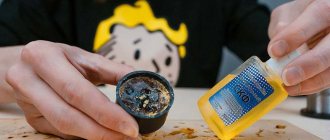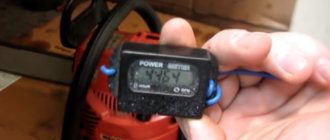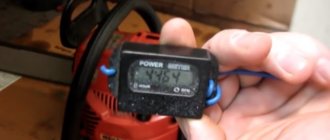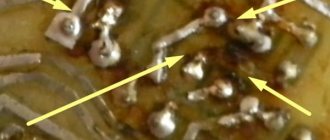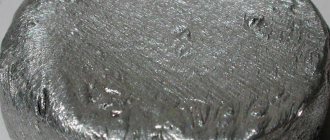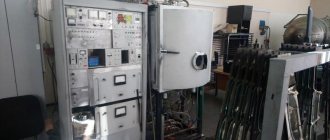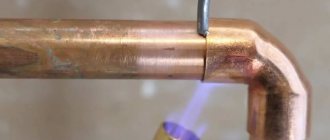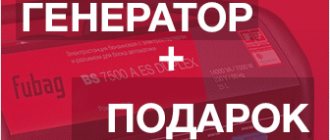Even in specialized forums and online communities, professional electricians cannot come to a consensus on a simple and effective way to connect copper and aluminum in household wiring.
What can we say about the ordinary home craftsman who encounters electricity from time to time. It is for such beginners that I review six popular methods of creating reliable electrical contact, showing their differences.
All you have to do is read the article on the site and choose for yourself the method that requires less effort and is easier to perform in order to ensure high electrical safety.
Problems with soldering aluminum
Aluminum oxide (Al2O3) in mineralogy is called corundum Source masterpaiki.ru
Most people who are friends with a soldering iron have tried to solder aluminum at least once in their lives and were convinced that it is almost impossible even after tinning with hydrochloric acid. But why is that? A film of aluminum oxide (Al2O3), which appears immediately after stripping, resists good contact with tin. This suggests that you first need to limit the possibility of the formation of an oxide film and only then start soldering - there is no other way.
Notably, aluminum oxide is a gemstone known as corundum. Depending on the impurity content, corundum can be red (with impurities of Cr), known as ruby, or blue, with impurities of iron (Fe) and titanium (Ti), known as sapphire. That is, solder cannot have adhesion to a stone, even a precious one.
Necessary tool
If you need to solder a wire or something else without a soldering iron, you need to prepare the following tool:
- pliers with thin noses;
- pliers;
- knife;
- scissors;
- sandpaper;
- file;
- needle file;
- brush.
An alcohol lamp or dry alcohol lamp should be used as a fire source.
The question of how to solder without a soldering iron seems absurd only at first glance. Such soldering can be done in very simple ways, or it can be done efficiently using solder paste.
For professionals, the title of the article may cause a condescending smile. It would seem, what’s so complicated here? I cleaned the contacts, scooped up some solder with the nose of the soldering iron, and applied it to the connection point. For an experienced radio amateur, this process really does not cause problems. But if everyone (including professionals) knows how to solder correctly with a soldering iron, where do unsoldered boards, short circuits between adjacent contacts, and parts that fail due to overheating come from?
Our material will tell novice craftsmen how to learn to solder using traditional and non-standard methods, and for those who consider themselves professionals, it will help improve their skills.
Video description
Soldering aluminum. Flux for soldering aluminum F-64.
Soldering with powder fluxes
The borax is intended for soldering using brass (copper) and silver solders Source expertsvarki.ru
Another opportunity to neutralize the oxide film (Al2O3) is the use of powder fluxes when soldering copper with aluminum. In such cases, a gas burner is most often used, and the powders are called powders. Perhaps someone imagines soldering as working with a soldering iron, but this is not entirely true, because for wires with a cross-section of 10 mm2 or more, a soldering iron is simply unsuitable, since it will not be able to heat them properly. Therefore, powder fluxes should not be discounted.
Here are some of the powders (powder fluxes):
- Sodium salt of boric acid, better known as borax (Na₂[B₄O₅(OH)₄]·8H₂O), is a white powder whose melting point is 700°C (the substance becomes viscous). This flux has a low cost, dissolves in water and is easily washed off with a solution of citric acid.
- Active flux F34-A. According to TU 48-4-229-87, it consists of 50% potassium chloride (KCl), 8% zinc chloride (ZnCl₂), 32% lithium chloride (LiCl) and 10% sodium fluoride (NaF). This substance is hygroscopic and dissolves well in water.
Safety precautions
During the soldering process, safety regulations must be followed.
These mainly include general precautions when working with the following equipment and substances:
- electric heaters;
- open flame;
- aggressive liquids.
The latter include fluxes. When performing the assigned task, it is prohibited to use faulty equipment
It is important to first inspect whether the insulation of the soldering iron is broken, and if necessary, replace the device
Safety regulations also prohibit the use of burners near flammable objects. In the room where work is carried out, it is necessary to organize forced ventilation.
Other methods for joining copper and aluminum
For connecting dissimilar wires, in this case, copper and aluminum, there are other methods that are fully justified, as confirmed by many years of practice.
Crimping method
When laying and installing electrical wiring, it becomes necessary to permanently connect copper and aluminum wires by crimping using sleeves Source samelectrik.ru
The soldering method for connecting aluminum and copper wires is not always suitable, and the reasons may be different. Firstly, you simply may not have flux, and the connection needs to be made urgently. Secondly, it may not be possible to connect to ≈220 V, and thirdly, there may be no free space to reach with a soldering iron. For example, in an electrical distribution box (dose), all twists must be well insulated, but the usual rag tape is not suitable in this case, since it allows oxygen to pass through, which will contribute to the oxidation of aluminum and, as a result, burnout of the twist. Therefore, one of the most optimal insulation options in such situations will be a sleeve - a fragment of the required length, cut from a heat-shrinkable tube.
Heat shrink is applied to the twist so that it captures the insulation on one and the other wire at least a centimeter at a time. First, the sleeve is put on one of the wires, then a tight twist is made, the thermal strip is moved so that it is in the center, but at the same time captures the insulation on both sides. After this, all that remains is to heat up the heat-shrinkable tube, and it will crimp both the insulation on both sides and the twist itself. It is usually heated with an ordinary burning match, and the sleeve cools down in 1-2 minutes. After this, the access of oxygen to the connection is stopped.
Terminal blocks
One of the most common ways to connect wires is with terminal blocks Source elektroznatok.ru
Terminal blocks or, as electricians call them, terminal blocks, are used to connect homogeneous and dissimilar conductive metal cores. For joining in a plastic block, bolted or clamp terminals are used, which ensure 100% contact and the complete absence of the influence of aluminum oxidation on copper. Between the terminals there is a shunt plate made of a neutral metal (usually tinned copper or brass), which is not affected by the oxide film. The most important thing in the terminal block is a good clamping of both wires, which guarantees a long service life. The only contraindication for such a connection is high air humidity. If this happens in such a room, then it is better to use heat shrink.
Surface preparation
Before you begin tinning, you must complete the following steps:
- degrease the surface using acetone, gasoline or any other solvent;
- remove the oxide film from the place where soldering will be performed. For cleaning, use sandpaper, an abrasive wheel or a brush with steel wire bristles. As an alternative, etching can be used, but this procedure is not so common due to its specificity.
It should be taken into account that it will not be possible to completely remove the oxide film, since a new formation will immediately appear in the cleaned area. Therefore, stripping is carried out not with the goal of completely removing the film, but to reduce its thickness in order to simplify the task of the flux.
Heating the soldering area
To solder small parts, you can use a soldering iron with a power of at least 100W. Massive items will require a more powerful heating tool.
Soldering iron 300 Watt
The best option for heating is to use a gas burner or blowtorch.
Simple gas burner
When using a burner as a heating tool, the following nuances should be taken into account:
- Do not overheat the base metal, as it may melt. Therefore, it is necessary to regularly monitor the temperature during the process. This can be done by touching the solder to the heated element. Melting the solder will let you know that the required temperature has been reached;
- Oxygen should not be used to enrich the gas mixture, since it promotes strong oxidation of the metal surface.
How to solder or desolder a microcircuit without a soldering iron
You already understand that successful soldering requires heating the part to the melting temperature of the solder. It can be melted using a heat gun or soldering hair dryer. This is an analogue of a construction hair dryer, only it is compact and often equipped with special molded nozzles.
With its help, the working area is heated, while the solder melts not at a certain point, but over a relatively large area. This is an effective method, especially if it is necessary to desolder the microcircuit (all legs heat up at the same time). But with this method there is a risk of damaging the part itself from overheating.
If you remove the faulty element, no problem.
In general, a soldering gun should only be used in cases where the traditional soldering method is not possible. For example, when mounting SMD parts (who doesn’t know, they don’t have legs) on a radiator plate.
